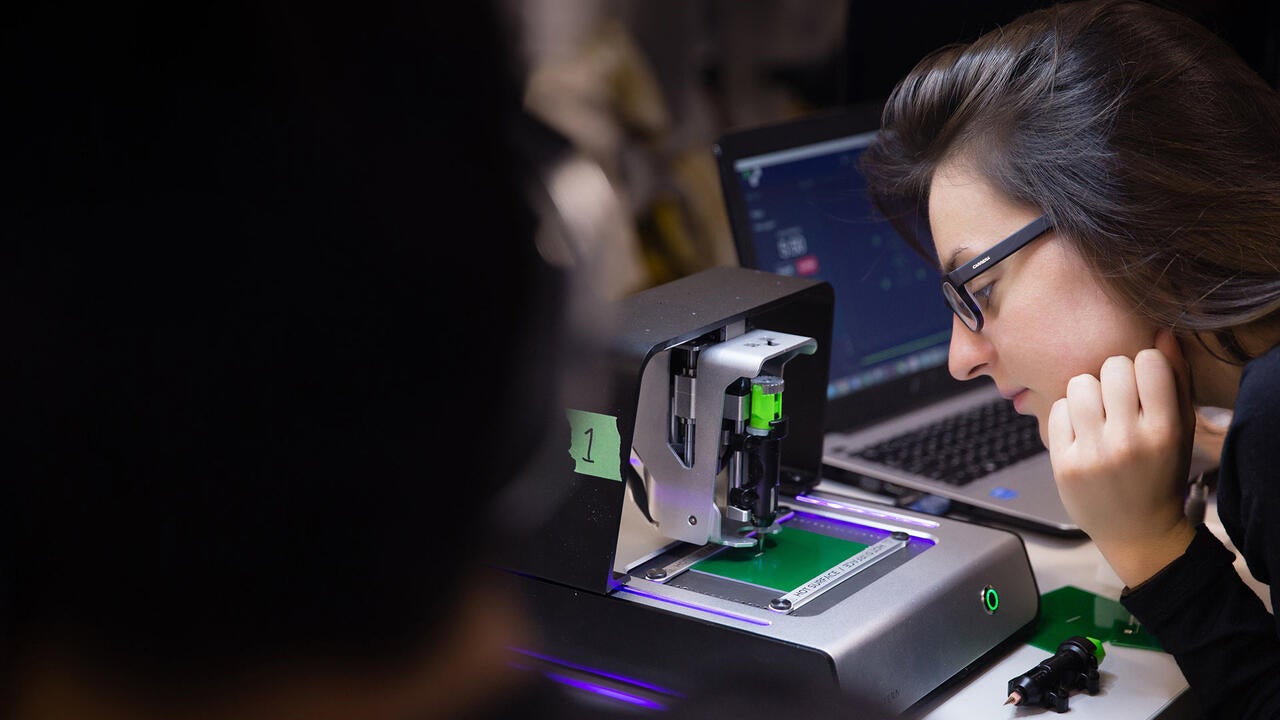
How a circuit board printer is accelerating innovation
Voltera: Award-winning Waterloo startup is shipping its printer to more than 60 countries around the world

Voltera: Award-winning Waterloo startup is shipping its printer to more than 60 countries around the world
By Rose Simone University Communications
Katarina Ilic (BASc ’13)
Alumnus, Faculty of Engineering and Faculty of Science
> Co-Founder, Voltera Inc.
Our digital future is becoming faster, cheaper and easier to manufacture.
One company at the heart of this electronic future is Voltera Inc., started by University of Waterloo alumni who have developed a compact printer that makes it easy to actually “just print” prototypes of printed circuit boards.
Printed circuit boards are found inside anything that is digital and electronic, be it a laptop, a smartphone, a television set or the computerized systems inside your car. On the surface, it looks simple. It is a board etched with a thin conductive pattern of lines that form a circuit to shuttle the electrical signals to various components, such as the microchips.
But making printed circuit boards is actually quite a complex process. Engineers design the pattern for the circuit on a computer, and then those designs need to be sent to a manufacturing plant, often overseas, that will generate the prototype, so it can be tested before being mass produced. Getting the prototype back can take days, or weeks. Meanwhile, if the design has to be tweaked and sent again to the plant to create the next iteration of the prototype, that’s another delay.
Even though it is called a “printed” circuit board, until now, it hasn’t been easy to just create one on a compact printer right from a desktop. That’s what Voltera has changed with the V-One, a printer that can do just that.
The company was launched in 2013 by a team in the Faculty of Engineering made up of Katarina Ilic, Alroy Almeida, James Pickard and Jesus A. Zozaya. The team spent a couple of years overcoming the engineering challenges of developing a silver nanoparticle-based ink that can easily be dispensed by their complex electromechanical system, using their custom software. What makes the tool so innovative is the unique fusion of chemistry, electromechanics, and software, which allow it to function.
Initially, Voltera worked out of the University of Waterloo’s Velocity Garage, but as demand and the company grew, it relocated to their own office and in-house manufacturing facility on Breithaupt Street in Kitchener.
The product has won multiple awards, including the top prize in the International James Dyson Award competition and more recently, the CPES2017 Commercialization Award from the Canadian Printable Electronics Industry Association.
Katarina Ilic, a co-founder who graduated with a degree in nanotechnology from Waterloo’s Faculty of Engineering and Faculty of Science, says the company now has more than 1,000 units shipped to more than 60 countries around the world. This year, Voltera hopes to come out with an improved version of its V-One, with additional features.
The V-One is more than just a product. It is also an innovation that is sparking new innovations.
About 80 per cent of the buyers of the V-One are developers, including the people who are now coming out with new and novel products in flexible electronics, such as smart jackets that heat themselves. Being able to easily print circuits on a printer makes those innovations easier to develop.
It is part of a $2 billion dollar printed electronics sector that is expected to become a $18 billion industry by the year 2021. “I expect it to boom in the next few years, now that developers have the tools to make these new types of products,” Ilic says.

Read more
Meet the Waterloo student enabling quantum computers to solve real-world problems

Read more
Waterloo computer scientists are developing technology to improve speech recognition and allow machines to give you better answers to your questions

Read more
Waterloo autonomous vehicle team is looking forward to longer public drives in 2018
The University of Waterloo acknowledges that much of our work takes place on the traditional territory of the Neutral, Anishinaabeg and Haudenosaunee peoples. Our main campus is situated on the Haldimand Tract, the land granted to the Six Nations that includes six miles on each side of the Grand River. Our active work toward reconciliation takes place across our campuses through research, learning, teaching, and community building, and is co-ordinated within the Office of Indigenous Relations.